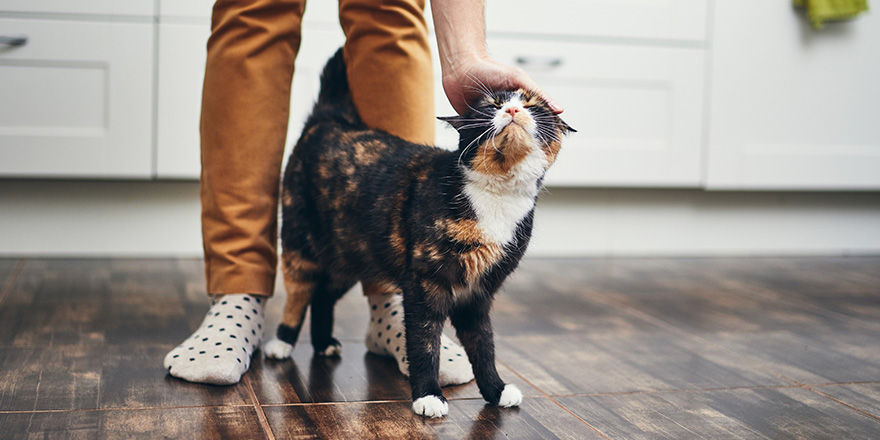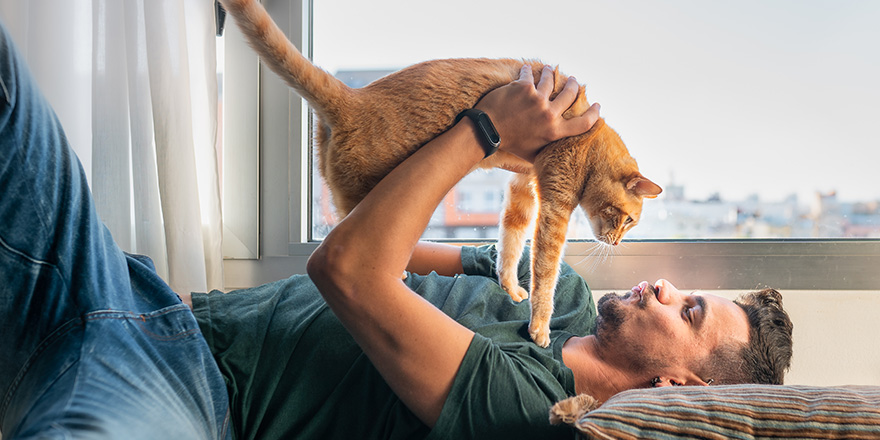When your cats feel comfortable around you, they are likely to come up to you for pets more often than not. They may start out by sitting in your space and watching you, which prompts most people to take that as a sign that it’s okay to pet them. Needier cats will eventually begin rubbing up against you, which is one way that they communicate their love and affection. Here, we explore why cats enjoy being petted so much, and where the root of the behavior comes from.
Why Cats Like Being Pet
When a human pets their cat they are unknowingly imitating the feeling that a cat gets when another cat grooms them. All cats see this as a positive experience from when they were kittens, but not every feline is going to be happy with being stroked. We’ll talk more about why some cats don’t like being pet as much as others later on in this guide.
Petting is soothing for cats. It’s something they associate with their mother from when they were young. Cats who are well-socialized will often have an affectionate and loving personality, where they will seek out attention from their owner so that they can get more pets.
In the wild, cats are known to participate in mutual grooming with other cats that they’re friendly with. When petting your cat, they are understanding your behavior and actions as a large, familiar cat that is grooming them. This is one of the reasons that your cat will groom you in return while you’re petting them.
Understand that cats aren’t like most dogs. The domesticated cat species is much more independent than domesticated dog breeds are, and they don’t require constant attention or human interaction.
Check out our article on how to hold a cat (the right way)!

Best Places to Pet Your Cat
Cats love being pet in a lot of different places! Physical contact is a great thing for cats because it helps socialize them and show them that you love them. However, not all cats enjoy being pet in the same places. The common “safe” places to pet a cat are:
- Their head, between their ears.
- Their chin.
- Their back, from their neck to their bottom.
Though it might be tempting to give your cat a belly rub, not all cat breeds will accept petting in this area. Wait until your kitty shows you their tummy and is purring before you attempt it.
Is Your Cat Being Demanding?
Many cats simply don’t like it when you aren’t paying attention to them. Cat lovers may have noticed their kitty headbutting their hands, face, phone, laptop, or anything that they’re holding. When a cat does this or rubs their head against you, they are trying to force your attention onto them. It’s not just kittens that display this behavior, either. In fact, you’re more likely to see adult cats demand attention because these social animals will have learned what does and doesn’t work to make you start petting them and giving them lots of fuss.
Is Your Cat Jealous of Other Cats?
Unfortunately, this jealousy expands beyond objects, and your pet cats will get jealous of any attention that other cats in your household are receiving. This can lead to a little bit of hissing or one cat batting another with their paw. Do not give in to the aggressive behavior of the cat you weren’t stroking and stop petting the cat you are giving attention to. Doing this will only reinforce that aggressive behavior. Instead, move the aggressor away and continue giving the first cat physical affection.
Homes with two cats or more will need to become familiar with a cat’s reactions and body language. It’s best to pay attention to your cats and figure out what they like before things go the wrong way and you end up getting clawed.
Ways Cats Prefer to Communicate
Cats learn how to communicate when they’re young. As a kitten, they will learn cat behavior from their mother and littermates, while also learning how to communicate with you through trial and error. It’s best to let a cat come to you on their own terms instead of disrupting their activity by going over to them and grabbing them. Domesticated cats are quick to show you when they want you.
For us humans, cats have learned to meow at certain times, wake us up when they’re hungry or bored, and often slot themselves into our day-to-day life with little fanfare. Body language is the main way your cat will communicate with you.

Cat Body Language for Cat Owners
Back Arching
Typically just a sign of an animal that needs to stretch, back arching has several other uses for cats.
When a cat is arching their back up while growling or hissing, they sense a threat, and owners should remove the stressor making them feel that way.
On the other hand, a cat with a down-arched back and a tail that is moving side to side may be hunting or playing. Is there a toy nearby, for example? Or a friend they enjoy playing with? Some cats also tend to enjoy attacking the feet of their humans.
Signs of Love
Slow blinks are a good sign because they point towards your cat showing that they trust you and don’t see you as a predator. The slow blink is widely known as one of the many ways that a cat says “I love you”.
Other signs of a happy, content cat are:
- Falling asleep next to you.
- Laying their tail over you.
- Putting their paw or paws on your hand.
- Sleeping/resting their head on your hand.
- Slow, sweeping tail movements.
- Rubbing their head or body against you.
When to Leave Your Cat Alone
Most cats will hide when they feel uncomfortable. If you can’t find your cat or you locate them hidden away in your home, don’t try and drag them out. Something has scared them and they are waiting out the threat. It could be as simple as a new person visiting or animals they don’t know (like other dogs they don’t live with).
FAQs:
Some feral cats can be friendly, but most are very wary of humans after being without human contact for so long. If the feral cat has someone feeding them, they are likely to be more open to touch. Otherwise, take in the cat's body language and always back off if they start to growl, hiss, or try to get away.
Unless it cannot be avoided at all - such as for medical treatment - you should not pet kittens until they are at least two weeks old, and even then you need to pet the mother first to get her scent on your hands before you touch her babies. Kittens should be socialized as early as possible. Without handling, the kittens may not be ready to leave their mother when you expect them to.







